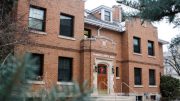Until last month in Montreal, the Association of Universities and Colleges of Canada (AUCC) had never officially invited students to participate in its membership meetings.
And why should they? The AUCC serves as a safe space for university and college presidents from across the country to talk in private about the best practices, develop public policy, discuss and design national strategies and share frustrations. Having students or faculty poking around may not be the best way to create an environment conducive to a free and easy exchange of ideas.
At least that’s one way to see the AUCC.
But there are other ways, too, as evidenced by my participation, along with nine other student leaders, in this year’s centennial membership meeting.
We were granted remarkable access to university presidents in a relaxed atmosphere that encouraged a frank, open and direct dialogue about our present and future education.
AUCC board of directors chair, Stephen Toope, president and vice-chancellor of UBC, opened the meeting with a passionate and optimistic address titled, “Opening us to larger worlds,” which set the meeting’s tone.
The “us” in the title, at least as I understood it, was directed largely at the presidents and their administrations. The “larger worlds” seemed to include civil society, K-12 education, university teachers, researchers, students, etc..
As part of that larger world, we the students — and by students here, I mean the entire Canadian post-secondary student body — were being sent a signal that the membership of the AUCC actually want to listen to us. They want us to join the conversation and want us to share in shaping and reshaping the collective answer to the question: “What good are universities?”
Of course, to take advantage of such an opportunity and participate meaningfully requires that we also genuinely listen to what the presidents have to say.
The dynamics of such a general, open exchange — if it’s to be successful and lasting — asks nothing less than a transformation of the university system, of how knowledge is produced, transmitted and consumed. It asks for a greater democratization of the learning process, which includes the acknowledgment that it actually occurs within a larger human ecology. It requires the universities’ departments of knowledge to become more permeable to private and public partnerships, without eviscerating academic freedom.
It asks, at the very least, that the space created in which this exchange is to happen and this new narrative is to be written — and make no mistake, this is a kind of utopian idea — is one where those who enter are permitted to make mistakes, to reason otherwise and to unashamedly behave with a childlike naivety.
We’re talking about a trusting space where the inevitable tensions that arise are treated as creative and collaborative, not destructive and divisive, opportunities. As Toope put it, “Our story is not about competition. It is about contribution.” Curiously, what we’re talking about seems to have much in common with the sort of larger learning space that universities themselves ought to be creating.
Complicating this, as if it weren’t complicated already, is that each university is embedded in a local context that propels it along its own trajectory.
Listening to presidents of different universities and colleges talk about their own specific histories, circumstances and challenges — especially, but not only, economic — it quickly became clear to me that, though they were impressed with Toope’s message, it would need to be massaged to have any chance of flying back home.
Still, us students who participated at the meeting left with some glimmers of hope. For example, we were encouraged by some of the discussions surrounding the co-curricular record (CCR), which recognizes non-accredited university activities — University of Manitoba launched its own this year. It’s an attempt by the university to formally note and support student development in a more holistic way by acknowledging leadership work, volunteerism and “service learning.”
While it’s in its infancy, CCR could, and should, one day count as accredited activities. It would never be the core of one’s undergraduate university education, nor would it be graded beyond pass/fail, but it does have the potential to open up and integrate more directly the larger community to the university and to create a circuit that combines different ways of generating knowledge.
So, how do we get from here to there?
Inviting students to participate like the AUCC did last month is a good first step.
Sure, some might see it as a stunt, a photo-op for the leaders of higher education to show they haven’t lost touch with the common student. But I choose to be more optimistic. What I witnessed at the meeting was a real passion for change, a genuine respect for tradition, and an earnest sense of public duty.
Yes, it took 100 years to get students there.
My guess: it’s not going to take anywhere near as long for us to be invited back.
Greg Di Cresce is hopeful for the future of Canadian universities.




